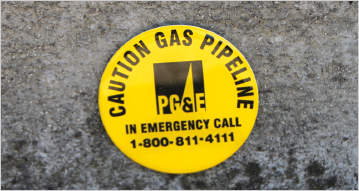Your new pge.com account is almost here! We’re adding easier password resets, improved security and more. Make sure we have your current phone number and email address so you don’t get locked out. Don't get locked out!
Error: Field cannot left blank.
Error: Invalid entry. Do not use equal signs [=] or colons [:].
Error: Field cannot left blank.
Error: Invalid entry. Do not use equal signs [=] or colons [:].
Trees and plants need space to grow above and below ground. Planting the right tree in the right place helps reduce power outages, prevent wildfires and maintain reliable service.
- Planting safely
- Tree work safety
- Call 811 before you dig
- Yard safety resources
Right Tree, Right Place
Help keep your community safe by planting the right tree in the right place. This starts with keeping trees and other plants away from PG&E equipment.
Any tree or plant that poses a risk to our equipment must be removed for safety. PG&E's land rights do not require us to offer compensation or request permission to remove these trees. Planting trees a safe distance away from PG&E equipment can help lower the risk of removal.
Safe Planting Overview
Learn how we can work together to keep our communities safe by planting safely near powerlines and pipelines.
Below are guidelines for planting near distribution poles and powerlines. This type of equipment is usually found in residential areas. To learn more, download our Guide to Planting Safely Near Overhead Powerlines Fact Sheet (PDF).
- All powerlines have a wire zone, which is the area right around poles and wires.
- The Distribution Wire Zone is the area within 15 feet of the wires. For safety, do not plant trees in the Distribution Wire Zone.
- What you can plant in the Distribution Wire Zone depends on where you live. To find out if you live in a High Fire-Threat District (HFTD), check the California Public Utilities Commission’s (CPUC) HFTD map.
- If you live inside an HFTD, plant only small plants shorter than 1 foot when mature in the Distribution Wire Zone. See the diagram below.
- If you don’t live in an HFTD, plant non-tree shrubs shorter than 10 feet when mature in the Distribution Wire Zone.
- Do not plant trees in the Distribution Wire Zone. This applies to both HFTDs and non-HFTDs.
- Trees with a mature height no taller than 15 feet may be planted outside of the Distribution Wire Zone (at least 15 feet from poles and wires).
- Trees with a mature height of more than 15 feet must be planted at least 50 feet out from the wires.
As part of our commitment to safety, we may need to remove any tree identified as a safety risk. This can apply to trees beyond 50 feet out from the distribution wires. Also, do not plant any vegetation within 10 feet of any pole or structure, or 5 feet of a guy wire. If there is underground equipment on or near your property, there may be additional safe planting guidelines.
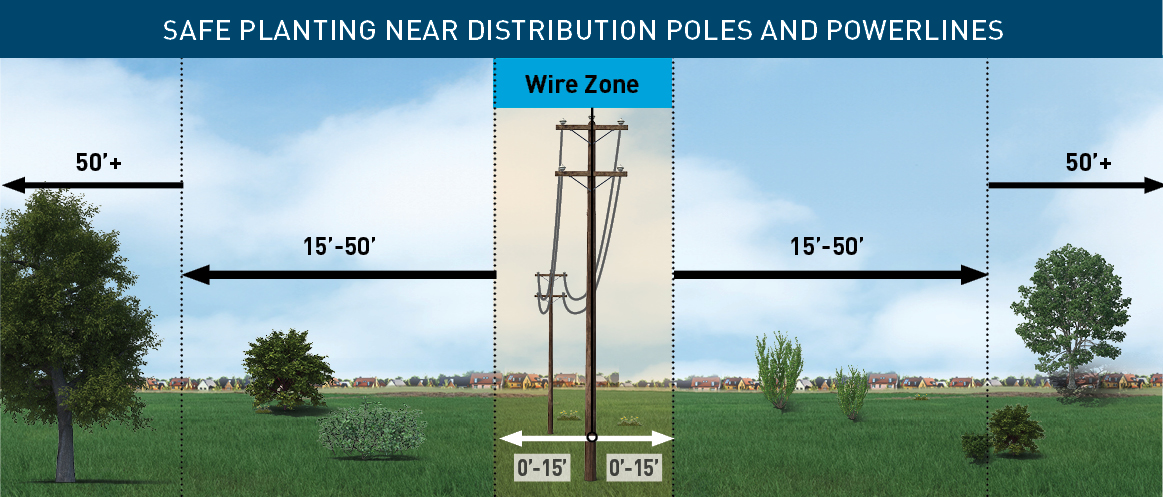
Below are guidelines for planting near transmission towers and powerlines. To learn more, download our Guide to Planting Safely Near Overhead Powerlines Fact Sheet (PDF).
- All powerlines have a defined wire zone, which is the area right around poles and wires.
- The Transmission Wire Zone is within 20 feet of the wires. For safety, do not plant trees in this area. Please note, this distance applies to 60kV equipment. As the voltage increases, so does the width of the Transmission Wire Zone.
- Within the Transmission Wire Zone, plant low-growing grasses and small plants shorter than 2 feet at maturity.
- Plant taller plants and shrubs that are shorter than 10 feet when mature about 20 to 60 feet out from the wires.
- Trees taller than 10 feet when mature must be planted beyond 60 feet out from the wires.
- No trees or shrubs may be planted where PG&E has the right to access land to maintain equipment.
We follow vegetation guidelines as required by law. As part of our commitment to safety, we may need to remove any tree identified as a safety risk. This can apply to trees beyond 60 feet out from the transmission wires. PG&E’s land rights do not require us to offer compensation or request permission to remove trees for safety. Planting trees a safe distance away from PG&E equipment can help lower the risk of removal.
In addition, do not plant any vegetation within 10 feet of any pole or structure, or 5 feet of a guy wire. If there is underground equipment on or near your property, there may be additional safe planting guidelines.
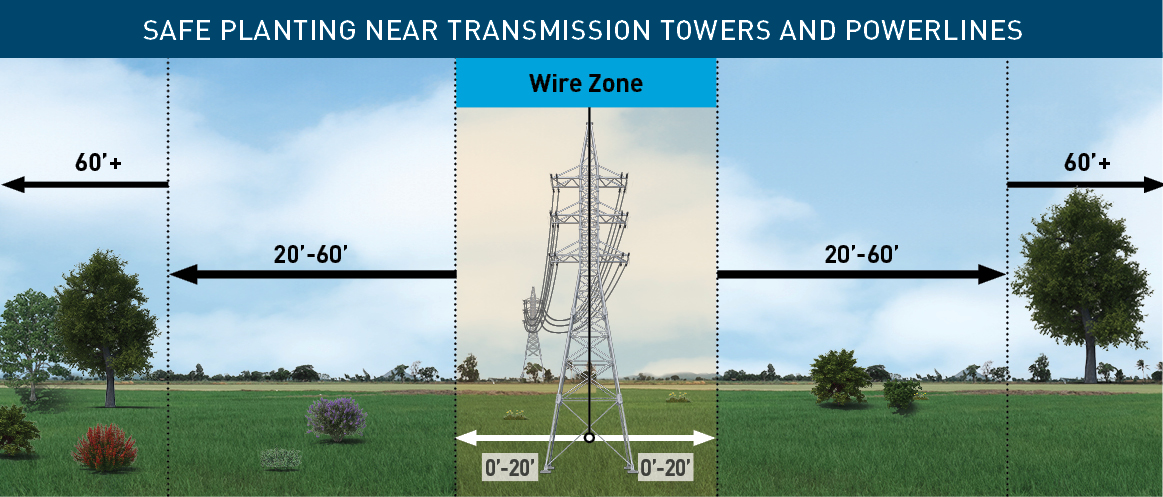
Plant at least 8 feet from the front and 2 feet from the back and sides of pad-mounted transformers.
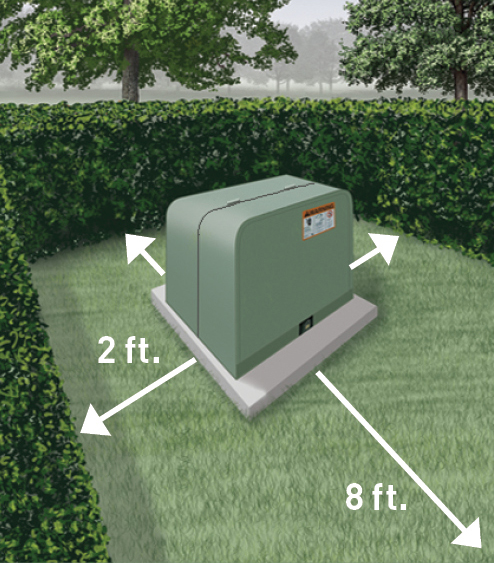
This image is an example of a pad-mounted transformer.
Below are guidelines for planting near gas transmission pipelines. Note that most gas transmission pipelines are below ground. To learn more, download our Guide to Planting Safely Near Gas Pipelines Fact Sheet (PDF).
The area near a gas transmission pipeline is separated into three zones.
- The Pipe Safety Zone is within 5 feet of a gas transmission pipeline.
- The Border Zone is between 5-10 feet.
- The Outer Zone is between 10-14 feet.
Many types of low-lying plants and shrubs work well in the area above the pipeline.
- In the Pipe Safety Zone, plant lawns, flowers, short grasses and low-growing plants.
- In the Border Zone, plant small to medium shrubs with a trunk or main branch less than 8 inches wide at chest height when fully grown.
- Within the Outer Zone, plant large shrubs and small trees with a trunk less than 36 inches wide at chest height when mature.
We recommend planting trees as far away from the pipeline as possible for safety. PG&E may need to remove any tree identified as a safety risk. Multiple factors are reviewed when considering removal of vegetation near gas pipelines including trunk size and soil condition, among others.
Always call 811 at least two working days before digging or planting so a crew can mark any underground utilities for free.
Use our interactive map to see if you live near a natural gas transmission pipeline. View the gas pipeline map.
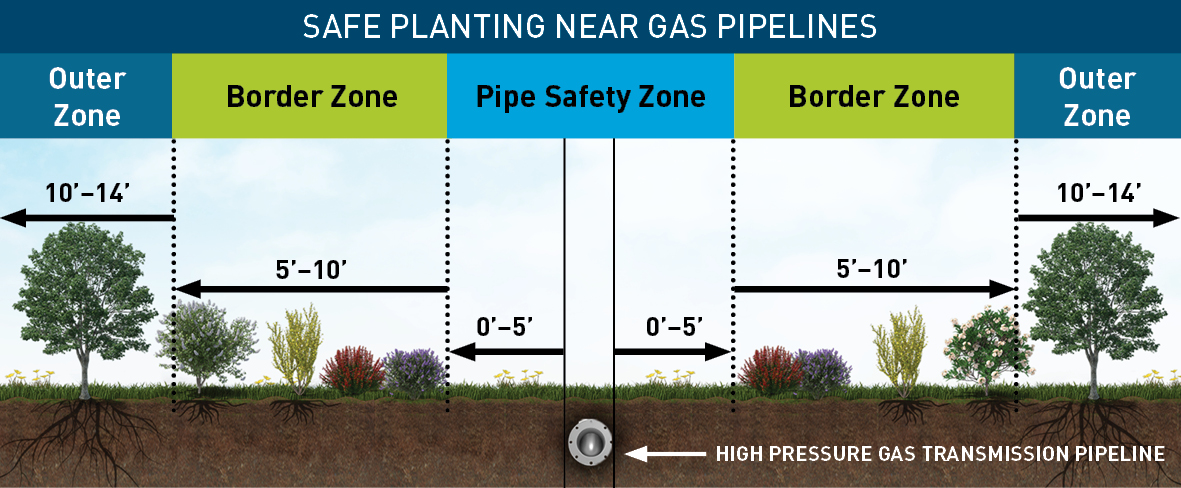
Planting tips
- Choose fire-resistant trees and plants.
- Create and maintain defensible space. This means creating a buffer zone between your home and nearby trees for protection against wildfires.
- Protect yourself when planting. Use proper gardening tools, apply sunscreen and keep water on hand.
- Always call 811 at least two working days before you dig or plant. Crews will mark any underground utilities for free so you can avoid them when digging.
- Submit plans for new buildings and major landscaping projects to PGEPlanReview@pge.com to avoid any interference with our equipment.
Additional information
Working safely near powerlines
Contacting a powerline can cause serious injuries or even death. Only line clearance-qualified personnel with special training and tools are legally allowed to work near powerlines.
When planting, trimming or removing vegetation near powerlines:
- Always look up to identify a powerline.
- Keep yourself and your tools at least 10 feet away from powerlines.
- Contact PG&E to request a free temporary service disconnect.
- If you have non-emergency concerns about trees near powerlines or your service wire, please report it through the PG&E Report It mobile app.
Creating defensible space
You can help stop the spread of wildfires by creating defensible space on your property. This means creating a buffer zone between your home and nearby trees for protection against wildfires. Steps you can take include:
- Trimming trees and other vegetation regularly.
- Removing any dry or dead vegetation within 100 feet of your residence or building.
- Leaving space around plants by removing debris and creating fuel breaks.
- Cutting grass to a maximum height of 4 inches.
- Choosing native and slow-growing, fire-resistant plants from your local nursery.
Additional resources
For more details about how you can protect your home and community, visit readyforwildfire.org. This website can help with:
- Planting a fire safe landscape.
- Hardening your home.
- Creating a firewise community.
Your local UC Master Gardener may have additional resources for your neighborhood.
Call 811 before you dig
To ensure that you remain safe when doing any digging projects, always call 811 first.
811 is a free service managed by Underground Service Alert (USA) and available to everyone. After you call, USA will contact PG&E and other companies that have underground lines in your area. Representatives will then mark the location of their underground lines so you can avoid them and dig safely.
Whether you are planting a tree or a garden, or digging holes for fence posts, call 811 at least two business days before you plan to start your project.
Remain safe during your next digging project by following these steps:
Step 1: Call 811
Call 811 at least two business days before you dig—the service is free.
Step 2: Identify and mark your digging area
Identify and mark your digging area with a white substance such as chalk, spray paint, flour or marking whiskers, tags, stakes or any combination.
Step 3: Leave the marks in place
PG&E and other companies will use colored utility flags, stakes or paint to mark underground lines following the American Public Works Association Uniform Color Code (PDF). Please leave the marks in place until you are finished digging. The marks are valid for 28 days.
Step 4: Use handheld digging tools when digging within 24 inches of the outside edge
Only use hand digging tools, such as shovels, within the 24-inch zone. After finishing your project, carefully backfill and compact the soil.
To submit an online request, please visit Underground Service Alert North.
Learn about the importance of calling 811 before any digging project, no matter how large or small, and to learn how to dig safely once any underground utility lines are marked for your project site.
You can also submit questions about your project to DamagePrevention@pge.com.
- Standby Hotline: 1-800-875-7915
- To request a free 811 training, email DamagePrevention@pge.com with the subject line "811 Workshop Request"
Downloadable PDF resources
- Dig-in Reduction Team (DiRT) Investigator Map (PDF) - Written in English
- 811 wall card (English) (PDF) - Written in English
- 811 markings brochure (PDF) - Written in English and Spanish
Note: The quiz mentioned in the video is no longer available.
Yard safety resources
PG&E has resources for homeowners and licensed contractors who may have questions or need to make contact with someone specific within our Damage Prevention organization and to help you dig safely.
If you suspect a gas leak or if you hit, accidentally dent, scrape or damage an underground gas line:
- Alert others in the area, leave immediately and move to a safe, upwind location.
- Do not light a match, use a cell phone or flashlight, operate a vehicle or use any electronic device near the leak.
- Call 9-1-1 for emergency assistance and then call PG&E at 1-800-743-5000.
Recognize signs of a natural gas leak
Please report any signs of a gas leak immediately. Your awareness and action can improve the safety of your home and community.
- 811 wall card (English) (PDF) - Written in English
- 811 markings brochure (PDF) - Written in English and Spanish
- Safety poster (PDF) - Written in English and Spanish
Damage Prevention organization
PG&E's Damage Prevention Department is comprised of Locate & Mark (L&M), the Dig-in Reduction Team (DiRT), Aerial & Ground Patrol, Standby Governance, Damage Recovery and Metrics, and Public Awareness. The Damage Prevention organization's vision is to work with the excavation community in a manner that fosters effective communication between all stakeholders to prevent public safety incidents resulting from excavation damage. The department seeks to educate the public about the USA Program to improve utilization of the system such that all excavation sites are located, and field marked for all subsurface infrastructure prior to the start of excavation. While PG&E's focus continues to be on responding to requests to locate and mark subsurface installations, educating the public about the existence of the 811 Program and each party's responsibilities in the process is also critical to improving safety on all excavation sites, protecting the public from excavation damage-related incidents and ensuring the reliability of the subsurface utility infrastructure. Each of the Damage Prevention programs works in concert to support the mission statement of the Damage Prevention and Compliance organization which is, "Demonstrate our commitment to public safety and damage prevention through regulatory compliance, education and awareness."
Contact: DamagePrevention@pge.com
PG&E's L&M Program is a component of the Damage Prevention organization within PG&E's Gas Operations. Today PG&E has more than 320 full-time employee locators across our coverage territory supplemented by additional contracted locating support. The L&M team responds to 811 notifications (also known as "tickets") from excavators who have requested to have their excavation site located and field marked, or cleared, for the presence of its subsurface installations. This is normally done by a locator in the field who will review records or maps and use specialized equipment to locate the underground utilities. The locations of the utilities are identified when the locators place marks on the ground such as paint, flags, whiskers or chalk. The marks are used to indicate the approximate location of an underground natural gas pipeline, electric cable or fiber optic cable.
Contact: LocateAndMarkManagerSupport@pge.com
The Dig-in Reduction Team (DiRT) is responsible for investigating all excavation related damages to PG&E-owned subsurface installations. DiRT members conduct investigations when incidents occur to include interviews with involved parties, overall scene analysis, USA ticket verification with photo review, and taking measurements related to the incident. DiRT members are familiar with California Excavation Law 4216 GC, Common Ground Alliance's (CGA) Best Practices, and other Federal Regulations related to safe excavation practices. DiRT focuses on preventing incidents from occurring by developing partnerships with excavators, having discussions around safe excavation practices, sharing lessons learned, and working in partnership to keep workers and the public safe.
Contact: DamagePrevention@pge.com
To request a free 811 training, email DamagePrevention@pge.com with the subject line "811 Workshop Request."
The objective of the Patrols Process is to observe and maintain surface conditions on and adjacent to the transmission pipeline right-of-way (GT ROW) in order to provide safe access to gas facilities, detect unauthorized excavation, and to document and report any factors affecting pipeline safety and operations. The Patrols Process also covers GT Vegetation Management and pipeline markers.
Contact: AerialGroundPatrolTeam@pge.com
The Standby Governance Team provides onsite PG&E representatives anytime excavation takes place near PG&E's Critical assets to ensure safe excavation practices are being implemented. PG&E provides Standby as a free service as we understand how important this role is in protecting contractors, our communities, and keeping our commitment of providing safe and reliable energy to California. Standby Inspector duties include: monitoring the excavation process, inspection the of PG&E's Gas facilities, reporting of any issues or abnormalities on the facility, observation of the backfill process, and educating excavators of best practices to keep everyone safe. Standby Inspectors are PG&E's "last line of defense" to protect our communities from a critical facility rupture as a result of unsafe excavation. Please help us keep California safe by requesting a Standby Inspector for your excavation when deeming necessary during your onsite field meeting.
Standby Hotline: 1-800-875-7915
Download field meet information brochure (PDF)
Download standby hotline areas (PDF)
PG&E is committed to on-going communications with the affected public, excavators, emergency response officials and public officials to maintain public safety by raising the awareness of pipelines and reducing the likelihood and potential impact of pipeline damage through education, resources and programs like 811 "Call Before You Dig." The Public Awareness Program is designed to enhance public safety, emergency preparedness and environmental protection through increased public awareness and knowledge and includes outreach activities for professional excavators (EX), local public officials (PO), emergency response officials (ER) and the general affected public (AP) who live and work within PG&E's distribution service territory and near transmission pipelines, gathering pipelines, storage facilities and compressor stations.
Contact: PublicAwareness@pge.com
Educational videos
- Why Aren't You Calling 811 Before You Dig?
- Call 811 (Cautionary Tale With Homeowner)
- 811 Pro DiRT
- How To Delineate
Natural gas transmission pipeline markers
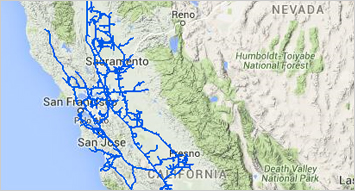
You can spot PG&E's larger transmission pipelines by looking for pipeline markers. They specify the approximate or offset location; however, not all pipelines follow a straight path between markers. These markers also indicate the need for extra care when digging in the area.
Use our interactive online map to find out if there are natural gas transmission pipelines in your area.
Additional information
For additional information about 811 and underground digging or to make an online request, visit these websites.
Frequently asked questions
- When trees grow too close to PG&E equipment, including powerlines and underground gas transmission pipelines, they pose a safety risk and can cause a power outage or ignite a wildfire.
- Vegetation planted too close to the natural gas pipeline can also delay emergency and maintenance crews.
- PG&E may trim or remove these trees and plants to keep our communities safe.
- Planting the right tree in the right place keeps our communities safe and avoids future tree trimmings and removals.
- Choosing the right tree can also reduce your property's fire risk. In general, avoid planting palms and bamboos near powerlines. These can become fire hazards, especially during high winds.
- It's important to consider the height and roots of a tree when it is mature.
- While a tree may not pose a concern as a sapling, a full-grown tree can block access to the pipeline in an emergency or for critical maintenance work.
- The tree could also damage our equipment as it grows, which can lead to outages.
- Picking the right tree and planting it in the right place can prevent it from becoming a safety concern.
- Transmission powerlines are usually located on metal towers up to 180 feet tall or wooden poles approximately 50 feet tall.
- They are like a highway that carries electricity at a higher voltage across longer distances, serving entire cities and towns.
- Distribution powerlines are usually located at the top of wooden poles.
- They are like city streets that bring electricity into your neighborhood and home.
- To see if you live near an underground transmission gas pipeline, you can check our Natural Gas Transmission Pipeline Map at pge.com/pipelinelocations.
- It is important to call 811 at least two working days before digging or planting. Crews will mark any underground utilities for free.
- We provide general guidelines to help you plant safely.
- However, each tree and location is different.
- Some trees may become unsafe for a variety of reasons.
- This could include changes in site conditions such as soil stability or tree health.
- Any tree identified as a safety concern will need to be removed to keep the community safe.
Utility owners have two working days, plus the day of the call to mark out their utilities. You will receive a positive response from all utilities responding to your USA ticket.
First step is to delineate your intended area of excavation in white paint, white flags or white markings, and then call 811 or use the online website to submit your request.
The FREE one-call service, or "ticket," is the document you submit through your local one-call center requesting utilities to mark or locate their facilities at your worksite at least two-working days before you begin an excavation. When you call 811 or visit california811.org to submit your ticket online, you will receive a ticket number for your individual request. The ticket number format is "YYYYMMDD" followed by the USA ticket numbers and revision number. For example: 2023040412345-00. Be sure to keep the ticket number assigned to your request for at least the duration of the excavation and preferably longer for your records.
California Government Code 4216(g) defines excavation as any operation in which earth, rock, or other material in the ground is moved, removed, or otherwise displaced by means of tools, equipment, or explosives in any of the following ways: grading, trenching, digging, ditching, drilling, augering, tunneling, scraping, cable or pipe plowing and driving, or any other way.
When digging in an area around utility lines, it is critical that you follow the tolerance zone guidelines. The tolerance zone is an area 24 inches on either side of the outside diameter (or center line if diameter isn't provided) of the marked utility line. In the tolerance zone, you are required to excavate using only human powered hand tools.
Utility companies will mark their lines wherever they own and operate their utility at your dig site. This could be in a roadway, sidewalk, front yard or even in a backyard. PG&E will mark on private property if a gas or electric line is present. Private utility lines (landscape irrigation and lighting, natural gas line to a barbeque, electrical line to a detached garage or shed, etc.) will not be marked since they are not owned by a utility.
Yes, call 811 or visit california811.org at least two working days before you dig, plant or begin any excavation project no matter how large or small. A utility line may be in close proximity to an existing fence or retaining wall you're trying to replace. California law requires you to use this FREE one-call service. The date of notification does not count as part of the two working-day notice. For example, If excavation will begin on Friday, an excavator must call no later than Tuesday.
Each person or company performing an excavation needs to have a ticket created under their name. If you are hiring a contractor to perform work on your property, the contractor needs to contact 811 and submit a request for them or their company. You may also submit a ticket under your name, but your contractor needs to be advised that the ticket you submit only covers any work you do yourself, and not the work they are doing.
Yes, call 811 or visit california811.org at least two working days prior to excavation, including digging and planting. Use hand tools at all times when working within 24 inches of the outside edge of any underground lines. Hand tools such as shovels or post-hole diggers cause the most amount of damage incidents.
811 is a FREE one-call service. Utility members fund the center and the cost of locating the utilities in an effort to provide the public a free service that will prevent or limit damage to underground utilities.
Yes, mark your project area in white paint. If you don't have white paint available, you can also use white stakes, white flags, white whiskers, white chalk and even white baking flour. If you neglect to pre-mark your dig site, utility members may choose not to locate their facilities.
If the damaged utility line poses a threat to life, health, or public safety, evacuate the worksite (300 feet or more upwind from damage) and contact 9-1-1 to dispatch emergency services. If you discover or cause any damage, such as breaks, leaks, nicks, dents, gouges, grooves, or other damage to subsurface installation lines, conduits, coatings or cathodic protection, you must immediately report it to the affected utility member. You can get the emergency contact information for the damaged utility owner by contacting 811 and notify them that you have damaged a facility at your worksite. Never attempt to fix, repair, pinch, squeeze, zip tie or bury the damaged facility.
If you suspect a gas leak or if you hit, accidentally dent, scrape or damage an underground gas line:
- Alert others to leave the area and go to a safe, upwind location.
- Call 9-1-1 to notify local first responders.
- Contact PG&E at 1-800-743-5000.
The utility members will use the American Public Works Association Color Code system to mark their underground facilities for you.
The color code is:

More on safety
Gas safety
Learn how to safely turn off your gas, what to do if you suspect a gas leak and more.
Carbon monoxide poisoning
Carbon monoxide is a dangerous gas. Play it safe with early detection.
Sewer cleaning safety
Cleaning out a sewer pipe can cause a gas leak if a gas line intersects the sewer pipe.
©2025 Pacific Gas and Electric Company
©2025 Pacific Gas and Electric Company

